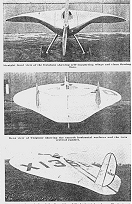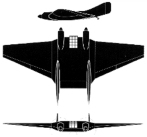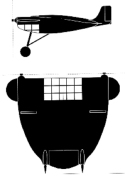| (This information was provided by Serge Krauss in response to an
e-mail that felt Burnelli hadn't been given the proper credit for blended
wing body type aircraft. It contains a lot information and reflects
the level of research that Serge puts into everything related to all wing
aircraft.)
The passionate defense of Vincent Burnelli invites comment, not just regarding priority in all-wing or BWB aircraft, but the excitement in aviation at that time. I’d like to highlight some of his many active, imaginative, sometimes visionary predecessors and contemporaries, whose ideas ranged from the erudite to the truly adventurous and even grandiose. Priority in aviation ideas has posed problems at least as far back as Wright vs. Curtiss. Early in this area where few had real expertise, what was actually possible and similarities in ideas may sometimes have been misunderstood. More confusing were original combinations and applications of previously recognized ideas. I have read seemingly equivalent claims in patents granted on supposedly different ideas. Also, where care is taken, descriptive ideas for a subject aircraft often far outnumber those surviving as patent claims. Finally, there are the cases of actual aircraft built, with or without patent protection. Concepts necessary in judging priority in BWB’s show considerable overlap and seem almost trivial today, when thick airfoils are common. The lifting-body concept cited by Mr. Geffner was important, but this can be deceptive and confusing. For instance, are we making a fuselage into part or all of a wing, a wing into a fuselage, or both? Patents appear to exist for each. What about “blending”? Fauvel, Junkers and Stout, among many, offer claims implying differing interpretations. Finally, there is configurational and structural variance, a more recent focus. SO…there are sources of confusion. I believe though that the key original ideas involved in BWB predated Burnelli’s. Below, I’ve cited pertinent patents and aircraft from Burnelli and others for your own perusal. Mr. Burnelli’s U.S. Patents seem to date from about 1928 (filed ca. 1921?), the earliest pertaining directly to tailless aircraft having been granted in 1935 (filed 1933): Burnelli, V.J.; U.S. Patent No. 1,987,050:"Tailless Airplane"; 1/8/35 (filed 2/23/33; all-wing tailless w/straight, deep center section to house load [not claimed; #1,758,498 of 5/13/30 cited], central l.e. engines and t.e. elevator, and swept lateral sections with c.p. aft of center section’s for stability; 4 pp., 7 figs.)(ex.c.) Griffin, E.G. (London, for Burnelli Aircraft., Ltd., U.S.); British Patent No. 445,634:"Tailless Aeroplane"; 4/16/36 (appl. 1/8/35; c.f. equivalent U.S. Pat. No. 1,987,050 of 1/8/35)(ex.nc.)  The tailless patent references a 1930 patent (filed 1921, the year his like-configured RB-1 flew): Burnelli, V.J., U.S. Patent No. 1,758,498: “Airplane”; 5/13/30 (filed 1/6/21; tailed biplane with wide airfoiled fuselage, containing engines, passengers, etc., and having conventional wings)(ex.c.)  Reference to the 1930 patent is made in the descriptive part of the tailless patent to show priority in enclosing engines, passengers, load, etc. in the center section, but new (allowed) claims ultimately concern only planview, engine location, and aerodynamics: relative lifting capacities and centers of lift for center vs. swept outer panels. So dating from 2/23/33, we have the intent to enclose all in a “continuous” wing, citing a 1921 idea that fuselages can be airfoil shaped. Airfoil shaped fuselage and non-blended wing thus apparently form the basis for a wing incorporating a fuselage, an idea that I believe was no longer patentable and which was not claimed in the tailless aircraft patent. Burnelli’s other early work concerned tailed types, many of which featured twin boomed stabilizers, relative c.p.’s of fuselage vs. wings, etc., if memory serves. I hope I’ll be corrected, if I’m wrong here, but I don’t remember reading any other directly relevant early Burnelli patents. So how does Burnelli’s timeline relate to other relevant patents and aircraft, and does it afford any priority in this area? Of patents by more than one hundred all-wing, BWB, and lifting-body creators listed in my bibliography (some having authored numerous planes), a few important ones do predate Burnelli’s Tailless aircraft patents. Perhaps surprising to some, even the fuselage-as-airfoil idea is trumped in this area. - by a well known patent. I should point out that almost all actual aircraft of these categories ever produced were compromises, and the “gray areas” could be argued forever. For instance, designers whose intent was to create large all-wing planes usually had to be content with aerodynamic proof of concept from smaller aircraft, which required protruding fuselage structures or open cockpits. Snyder, the Hortens, and Stout are examples. Visibility was also a factor. Note too the apparently separate patent recognition given low-aspect-ratio all-wing or lifting-body types (e.g. Snyder, Stout below). The following relevant published, patented, or constructed ideas predate Burnelli’s tailless-aircraft patent. At least TWO predate all of V. Burnelli’s patented work, Junkers also incorporating a “blending” idea in his text. I’ll just cite those that specify or show useful load (including the pilot) being carried within the lifting surface (wing) contour, whether or not it is “blended”. JUNKERS, H.: Ger. patent No. 253,788, 11/14/12 (2/1/10 -'the 1910 patent'); U.S. patent No. 1,114,364: “Flying Machine”, 10/20/14 (1/26/11, the equivalent U.S. patent).
The famous “1910 patent” is for carrying pilots, engines, and other load within lifting surfaces. It is looked upon as the pioneering patent in that field. A significant quote from its claims: “…means for connecting said wings and said shell, so as to offer a smooth surface to the air, …”. This and his figures 8 and 9 above suggest the blending of wing and airfoiled “body” or “shell”. Junkers, among several of this time, also proposed giant flying wings, here a 10-engined proposal of 1930:
This wing configuration incorporates ideas of Burnelli’s later all-wing patent, the outer panels functioning after pioneer J.W. Dunne or, by a stretch, Etrich and other Zanonia exponents. Junkers also proposed the giant J1000 canard with passenger-carrying wing in 1924 and built the more conventional G38 transport in 1927.
His British patent #149,708 of 2/17/19 enclosed all but
the pilot’s head within a low-A/R, tapered wing:
In this patent, wing surfaces taper from surfaces 6 and 7 of the cabin to the tips. His #149,709 specifies “An aeroplane in which substantially all detrimental surfaces are located within the camber of the planes, as in Specification 149,708”, but is provided with a sealed transparent canopy and other transparent “panels”. Again, other than the tapering, we see otherwise apparently equivalent ideas by Junkers and Stout given separate recognition for differing aspect ratios. Regarding nationality, whether or not recognized by a British patent, the Junkers patent idea was publicized in the British press. Nationality was definitely not an issue later for Snyder and Junkers, both of whom were granted U.S. patents. Stout built a diamond-shaped low-A/R "Batwing" tailless, which flew in late 1918. An attempt at cantilevering through a thick wing that could house structure, pilot, and propulsion, it of necessity had a protruding fuselage. In a later, corresponding U.S. patent, No. 1,862,102 of 6/7/32 (filed 3/29/19) a partial fuselage again protrudes.
FAUVEL, CHARLES: Of his early planes and patents, these seem relevant. AV-1: W.T. tests only, 1926? [Tunstall: 1928 or later]; AV-2 constructed, flew 1929-30; Fr. patent: filed 6/2/29; U.S. patent: No. 1,915,055 of 6/20/33 (2/24/30); Br. patents: No. 344,653 of 3/12/31 (2/28/30), No. 474,065 of 1/17/36 (void). The AV-2 was definitely a BWB, although the engine was in a raised pod. The slightly later AV-3 was compromised (minimized pod “fuselage”). Patent drawings below show the AV-2 configuration. Claims include “central portion of airfoil profile…wings having substantially similar parallel profile sections from said central portion to their respective tips.”
CHRISTMAS, W.W.: U.S. Patent No. 1,797,326: “Flying Wing Airplane”, 3/24/31 (filed 7/18/29; thick wing w/twin-boomed tail). Claims include “a single continuous wing…without any central fuselage or equivalent enlargement,…central section having sufficient head room within itself to accommodate persons…” SNYDER, C.L. (later w/HOFFMAN, R.): U.S. Pat. No. 1,855,695: “Aircraft”, 4/26/32 (filed 9/8/30; a controllable “compartment” lifting body with straight l.e. joined to curved t.e., and length approximately equal to span; pref. embodiment describes pilots, passengers, engines, etc. inside airfoiled, possibly buoyant body):
Dr. Snyder’s low-A/R “Dirigiplane” glider flew and was then motorized in 1932 as the S-1. Highly successful powered versions, like the 1933 ARUP S-2 at right, grew protruding fuselages with airfoil contours to the extent thought necessary on such a small plane. While the aircraft and proposals appearing above featured patented ideas that could serve as bases for all-wing or BWB aircraft, the following aircraft incorporate pertinent features which appear not to have received patent recognition. Related patents are mentioned. These all reflect a shared adventurous spirit among a variety of Burnelli’s contemporaries working independently, but embody relevant ideas appearing before and up to the filing or publication dates of Burnelli’s tailless aircraft patent. TSCHERANOWSKI, B.I.: This prolific creator of tailless types began with all-wing parabolic gliders in 1924. They may be the subjects of patents I have not found.
LIPPISCH, ALEXANDER: This pioneering genius of tail-less aircraft also envisioned giant flying-wing transports with great carrying capacity within the wings. Proposals from 1928 and 1930 employ his successful “Storch” and “Delta” series configurations, respectively. His writings show that he was long interested in achieving an all-wing ideal.
BEL GEDDES, N. (KOLLER, O.): 525'-span, 10-engined, swept, all-wing flying boat, w/2 upper surface vertical fins near each tip and engines mounted on auxiliary surface above l.e.: "Air Liner No. 4", designed/proposed (not constr.) 1929.
LESH, L.J.; U.S. Patent No. 1,859,568:"Airplane"; 5/24/32 (filed 2/28/29; `principle of similar proportional profiles and aerofoil continuity' suited to and perhaps ideally expressible in low-A/R tapered tailless; an example of blending ‘wing’ and ‘body’). CHARPENTIER, J.F.G.M.L.: multiple patents for tailless aircraft with load carried within wing. Claims though generally concern 3-element configuration (deep ctr., tapered outer panels, separated by twin fuselage elements w/vert. fins), control, and stability on planes that approach BWB shapes. Relevant aircraft: "C-1" Caudron tri-motor, constr. 2/33-10/12/33, taxied 10/15/33, taxi/takeoff crash 10/33, destroyed on take-off 1/35. Fr. patents: 674,280 of 10/21/29 (4/30/29, 1/27/30), 711,979 of 7/8/31 (6/4/30, 9/22/31), Addit. 40,110 to 711,979 on 1/19/32 (4/16/31, ?), 768,626 of 5/22/34 (5/2/33, ?), 770,705 date unkn. (6/16/33, ?), 799,706 of ? (5/22/35, ?), addit. 47,125 to 799,706 on ? (3/2/36, ?), 867,149 of 7/7/41 (6/1/40, ?); Br. patent: 375,515 of 6/30/32 (6/1/31); U.S. patents: 1,893,129 of 1/3/33 (5/26/31), 2,123,096 of 7/5/38 (3/23/36).
French patent drawings (above right) suggest more of a BWB. Charpentier’s man carrying C-1 took on less of an all-wing appearance, due to scale limitations. NORTHROP, J.K.: His much publicized "All-Wing" flew 9/26/29 and was meant to be the subject of his U.S. patent No. 1,929,255 of 1/3/33 (5/10/29) below. This design was actually a twin-boomed, tailed aircraft to test the idea of carrying the propulsion and load in the wing, with the intention of then building true all-wing aircraft. Of course the great Northrop wings of the 1940’s (and then the B-2) were its descendents. Despite the patent’s full description of the all-wing concept, claims had been reduced to just landing gear mechanisms.
JOHNSON, R.B.: U.S. Pat. No. 1,887,411 of 11/8/32 (8/12/31, below left); Low-A/R “Uniplane” (A/R =1, below right) flew 8/34. Johnson’s patent concerned only the wing’s geometry, but the plane itself was actually a BWB by strict definition, employing the M-6 airfoil.
HORTEN, R. and W.: although the first Horten man-carrying glider was built in 1932, their model research began in 1928. Most of their early designs, powered or otherwise, were attempts at an all-wing ideal, with only very small protuberances for pilots. Their well-known efforts fill books. Two of their earliest:
ZIMMERMAN, C.: The creator of the V-173 first built
this 7’ man carrying all-wing or lifting body in 1935, but it never flew
(illus. by A. Pelletier).
LAMANNA, C.: BWB bomber model wind tunnel tested, 1935 (below).
I probably have other similar patents and published ideas hidden in my files, but I believe those I’ve cited show that ideas necessary for BWB’s predated Vincent Burnelli’s, and that there were other deserving, similarly engaged researchers and builders of his own time and earlier - an exciting period. This is NOT meant to denigrate Burnelli’s work, since he created remarkable practical aircraft and surely did not deserve to be snubbed. He just did not originate the first ideas necessary for all-wing or BWB development. So I would not contest that Mr. Burnelli’s accomplishments were impressive and deserved better acceptance, but I would question how original any inclination toward a BWB configuration actually was in 1933 or later. If you would like to explore the cited patents, the USPTO
has a great search engine on their internet site, where you can easily
find any of these and judge for yourself.
|


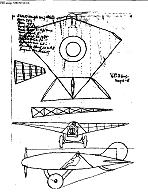 STOUT,
W. (father of the Ford “trimotor”): Here’s his drawing, dated 5/16/18,
for a low-A/R, all-wing light plane with pilot and engine within wing (NASM
from P. Vigneron):
STOUT,
W. (father of the Ford “trimotor”): Here’s his drawing, dated 5/16/18,
for a low-A/R, all-wing light plane with pilot and engine within wing (NASM
from P. Vigneron):
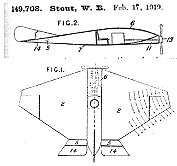
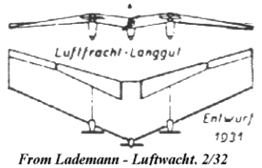 LANGGUTH,
W. (LUFTFRACHT CO.): Ger.; swept tractor trimotor commercial plane w/span-
and chord-distributed load: proposed 1929-31 (DNF); U.S. Patent No. 1,924,996
of 8/29/33 (filed 1/23/32): “Tailless Airplane”. Claims include load
at each (spanwise and chordwise) point approximately equaling lift at that
point.
LANGGUTH,
W. (LUFTFRACHT CO.): Ger.; swept tractor trimotor commercial plane w/span-
and chord-distributed load: proposed 1929-31 (DNF); U.S. Patent No. 1,924,996
of 8/29/33 (filed 1/23/32): “Tailless Airplane”. Claims include load
at each (spanwise and chordwise) point approximately equaling lift at that
point.

 SOLDENHOFF,
ALEXANDER: noted Swiss creator of tailless light planes also patented
giant flying wing designs with internal seating. Of his many patents, British
patent No. 383,637 of 5/21/31 (c. 5/22/30) and U.S. patent No. 1,848,752
of 3/8/32 (5/19/31), for thick monoplane center w/biplane tips, are relevant.
There may be others.
SOLDENHOFF,
ALEXANDER: noted Swiss creator of tailless light planes also patented
giant flying wing designs with internal seating. Of his many patents, British
patent No. 383,637 of 5/21/31 (c. 5/22/30) and U.S. patent No. 1,848,752
of 3/8/32 (5/19/31), for thick monoplane center w/biplane tips, are relevant.
There may be others.
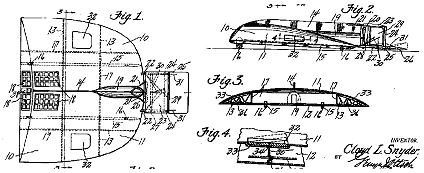
 ................
................

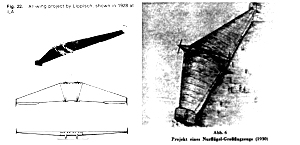


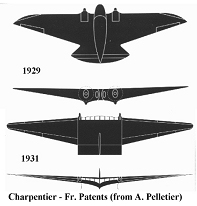 .................
.................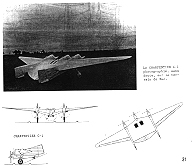
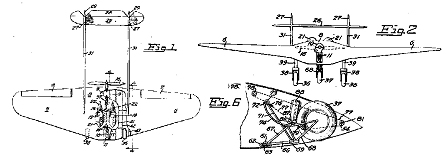
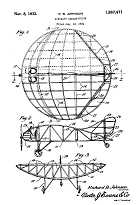 ..................
..................